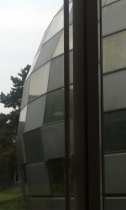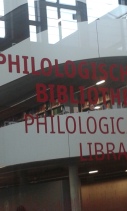![10672200_10204082125147292_2799875062790908748_n[1]](https://citylibresearchers.files.wordpress.com/2014/10/10672200_10204082125147292_2799875062790908748_n1.jpg?w=180&h=300) One of the most interesting parts of my visit was presentations by the Elearning team (CeDis) who provide training, support and consultancy.
One of the most interesting parts of my visit was presentations by the Elearning team (CeDis) who provide training, support and consultancy.
They define their work into 3 areas: 1. elearning (blogs and wikis, e-examinations, educational software, social software..), 2. eresearch (E-Publishing, multimedia archives, open access.) and 3. multimedia (web publishing, AV and multimedia). The university uses Blackboard Learn as its virtual learning environment, online courses using lecture capture software have had positive feedback. The University is currently working on a corporate design template for its website. This should make it easier to format webpages and make them consistent and mobile responsive. The University uses ITunesU for videos and teaching.
In terms of statistics, the University has 12 departments, 157 BA/MA courses, 29,000 students, 2600 staff and 4,800 doctoral students. A very high proportion of the staff and students are users of Blackboard Learn. Blogs and wikis are heavily used in teaching for example an flipped classroom wiki and a literature searching experience sharing wiki.
The Library uses the Primo portal as its resource discovery tool. This is also heavily used in the UK. There is also a Library catalogue with contains both the approx eight million items held in FU libraries as well as licensed electronic resources such as databases, e-journals, and e-books, but no direct links to articles. Primo can be used to cross search databases and pre-loaded quick sets can be used or users can create their own quick sets (not everything is cross-searchable). Like other resource discovery tools, Primo can produce 100,000s of results for a search and users have to depend on the relevance ranking being appropriate for the search and filtering to work well.
In terms of user support, a programme of information literacy workshops are held and there is a booklet for these. Some bite size 45 minute courses are held. Other workshops include citation searching, literature searching, reference management (Citavi) and appointments for ‘coaching’ can be booked. Captivate and Camtasia are used for tutorial videos eg. on using Primo.
I enjoyed visiting the University and was made very welcome by colleagues but also had the opportunity to visit Berlin. Berlin was great and I really liked seeing the sites such as Unter den Linden, the Reichstag, Potsdamer Platz, a boat trip and visiting the Zoological Garden and spending time with the tigers. I learned that understanding the historical context helps to understand the present.

![10526150_10203760296661781_3721713040976110358_n[1]](https://citylibresearchers.files.wordpress.com/2014/10/10526150_10203760296661781_3721713040976110358_n1.jpg?w=180&h=300)
![Btxaa5vIYAAThQr[1]](https://citylibresearchers.files.wordpress.com/2014/09/btxaa5viyaathqr1.jpg?w=117&h=188)


![BtzNGquIQAA5Cnz[1]](https://citylibresearchers.files.wordpress.com/2014/08/btzngquiqaa5cnz1.jpg?w=179&h=300)